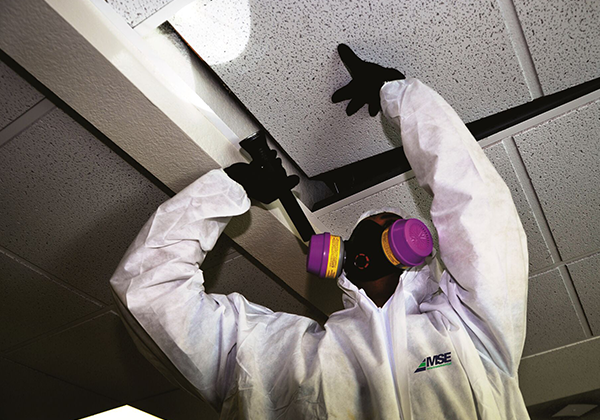The Complete Process of Accredited Asbestos Checking to Ensure Property Compliance
In the world of home management and conformity, the process of accredited asbestos screening stands as a critical part to guarantee the safety and wellness of occupants. From the first evaluation to the last interpretation of outcomes, each stage plays a vital function in identifying the visibility of asbestos within a home.
Accredited Asbestos Testing: Preliminary Analysis
In carrying out the first evaluation for certified asbestos screening, a meticulous assessment of the residential or commercial property's products is important to properly determine potential asbestos-containing materials. This critical step includes aesthetically checking all areas of the property, including ceilings, walls, floor covering, insulation, and various other building materials that might nurture asbestos. Unique attention is provided to products that are vulnerable to damage or disturbance, as these circumstances can launch harmful asbestos fibers into the air. Furthermore, sampling of presumed materials may be essential to confirm the visibility of asbestos through lab evaluation.
Recognized asbestos assessors adhere to strict procedures set by governing bodies to make certain the accuracy and dependability of the screening procedure. By meticulously documenting searchings for and making use of innovative screening techniques, assessors can offer homeowner with a thorough report detailing the presence of asbestos, if any, and the suggested steps for mitigation or removal. This preliminary analysis establishes the structure for succeeding activities to resolve asbestos worries and guarantee the safety and conformity of the residential property.
Sample Collection Procedures for Asbestos Examining
Reliable example collection procedures are important in making certain exact asbestos testing outcomes and compliance with governing standards. When gathering samples for asbestos screening, it is crucial to comply with strict procedures to decrease the danger of contamination and make certain the reliability of the outcomes.
Firstly, it is necessary to recognize the thought asbestos-containing materials (ACMs) and focus on sampling areas based upon elements such as the product's condition, accessibility, and potential for disruption. Asbestos Testing. Samples must be accumulated from different locations within the building to supply a comprehensive analysis of asbestos presence
Throughout sample collection, accredited professionals must wear proper personal protective tools (PPE) to protect versus asbestos exposure. They need to make use of clean devices, such as non reusable gloves and plastic bed linen, to stop cross-contamination in between examples. Examples should be thoroughly collected utilizing a specified technique, such as wet wiping or coring, and safely secured in airtight containers to protect their honesty during transportation link to the lab for evaluation.
Laboratory Analysis Refine for Asbestos Examples
Upon conclusion of the sample collection procedure, the asbestos samples are carefully delivered to approved research laboratories for thorough evaluation. The first action in the lab analysis process is example prep work, where the accumulated examples are very carefully processed to extract the asbestos fibers.

Once the analysis is full, a comprehensive record is produced, outlining the searchings for and verifying whether asbestos exists, the type of asbestos fibers recognized, and the concentration degrees. This information is important for homeowner to take the needed steps to make certain compliance with asbestos regulations and guard the health and wellness of residents.

Reporting and Analysis of Asbestos Examination Outcomes
Certified asbestos testing laboratories give in-depth reports that supply important understandings right into the visibility, type, and concentration levels of asbestos fibers discovered in examples accumulated from residential or commercial properties. These reports are necessary for homeowner and managers to comprehend the threat posed by asbestos and make informed decisions regarding its administration or elimination. The reports commonly include details on the methods utilized for screening, the places where samples were taken, the type of asbestos recognized (such as chrysotile, amosite, or crocidolite), and the concentration levels of asbestos fibers detected.
Interpreting these outcomes calls for expertise pop over here to assess the potential wellness dangers connected with asbestos direct exposure, identify the proper course of action, and make sure governing compliance (Asbestos Testing). Depending on the findings, referrals might range from continued tracking and upkeep to encapsulation or full asbestos abatement. Homeowner need to meticulously review these reports and consult with asbestos experts to establish a thorough prepare for addressing any asbestos issues determined
Making Sure Building Conformity With Asbestos Rules
To keep adherence with asbestos regulations, building proprietors must faithfully carry out measures to make certain compliance with suitable legislations and guidelines. This consists of conducting routine asbestos inspections by recognized professionals to recognize any visibility of asbestos-containing materials within the residential property. Once asbestos is determined, homeowner must adhere to asbestos monitoring prepares that summary proper control, elimination, or encapsulation treatments to avoid exposure and spread of asbestos fibers. Conformity likewise involves maintaining in-depth records of asbestos testing, upkeep, and removal tasks for assessment functions.
Homeowner must offer asbestos awareness training to workers and residents to minimize the threat of asbestos exposure and make sure proper handling of materials that might contain asbestos. Furthermore, it is essential to remain educated about any type of updates or adjustments in asbestos policies to readjust management practices appropriately. By proactively addressing asbestos compliance demands, homeowner can produce a secure environment for residents and alleviate possible legal and health dangers connected with asbestos direct exposure.
Conclusion
Finally, certified asbestos screening is a crucial process for guaranteeing residential or commercial property compliance with guidelines. The preliminary assessment, example collection procedures, research laboratory analysis, and interpretation of outcomes are all essential action in this process. By adhering to these treatments, homeowner can determine and attend to any asbestos threats present, protecting the health the original source and wellness and safety of passengers and maintaining conformity with regulatory demands.